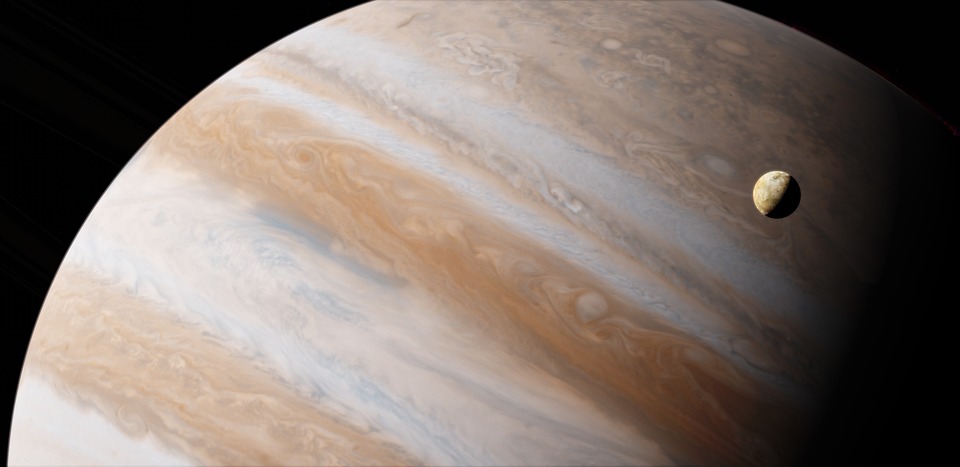NASA is closely monitoring other planets in our solar system for signs of unusual activity in order to learn more about the universe. The Juno spacecraft was able to capture unusual weather within the gas giant as it managed to spot cyclones forming in its atmosphere.
The agency’s Juno spacecraft snapped an image of cyclones on Jupiter. The cyclones were spotted on the gas giant’s northern polar region, with wind speeds of nearly 400 miles per hour. The image released by NASA was in “extreme false color” and the different colors represented various features of the gas giant’s atmosphere.
“Cyclones at the north pole of Jupiter appear as swirls of striking colors in this extreme false color rendering of an image from NASA’s Juno mission. The huge persistent cyclone found at Jupiter’s north pole is visible at the center of the image, encircled by smaller cyclones that range in size from 2,500 to 2,900 miles or between 4,000 - 4,600 kilometers. Together, this pattern of storms covers an area that would dwarf the Earth,” said NASA about the photo.
Since it’s launch in 2011, the Juno spacecraft arrived at Jupiter in 2016 and started a polar orbit. The mission also happens to be the first mission that gave scientists a clear view of the polar regions of Jupiter.
Aside from the cyclones, the Juno spacecraft also snapped a lunar eclipse that occurred over Jupiter. The eclipse cast a black hole-like shadow over a part of the gas giant as one of its moons, Io, passed over. The image of the lunar eclipse was taken during the spacecraft’s 22nd flyby. Io happens to be one of the innermost and the third-largest of the planet’s four Galilean moons.
“Jupiter’s volcanically active moon Io casts its shadow on the planet in this dramatic image by NASA’s Juno spacecraft,” said the agency.
Because of the number of moons that Jupiter has, eclipses such as this one happen more frequently. Io is also the most volcanically active object in the solar system, according to NASA. Volcanic activity on Io could easily be seen because of its thin atmosphere when it spews material.



 FDA Adds Fatal Risk Warning to J&J and Legend Biotech’s Carvykti Cancer Therapy
FDA Adds Fatal Risk Warning to J&J and Legend Biotech’s Carvykti Cancer Therapy  Is space worth the cost? Accounting experts say its value can’t be found in spreadsheets
Is space worth the cost? Accounting experts say its value can’t be found in spreadsheets  NASA and Roscosmos Chiefs Meet in Florida to Discuss Moon and ISS Cooperation
NASA and Roscosmos Chiefs Meet in Florida to Discuss Moon and ISS Cooperation  Blue Origin’s New Glenn Achieves Breakthrough Success With First NASA Mission
Blue Origin’s New Glenn Achieves Breakthrough Success With First NASA Mission  Trump and Merck KGaA Partner to Slash IVF Drug Costs and Expand Fertility Coverage
Trump and Merck KGaA Partner to Slash IVF Drug Costs and Expand Fertility Coverage  SpaceX Starship Explodes in Texas During Test, Citing Nitrogen Tank Failure
SpaceX Starship Explodes in Texas During Test, Citing Nitrogen Tank Failure  Lab-grown meat: you may find it icky, but it could drive forward medical research
Lab-grown meat: you may find it icky, but it could drive forward medical research  Trump Signs Executive Order to Boost AI Research in Childhood Cancer
Trump Signs Executive Order to Boost AI Research in Childhood Cancer  Cogent Biosciences Soars 120% on Breakthrough Phase 3 Results for Bezuclastinib in GIST Treatment
Cogent Biosciences Soars 120% on Breakthrough Phase 3 Results for Bezuclastinib in GIST Treatment  NASA Astronauts Wilmore and Williams Recover After Boeing Starliner Delay
NASA Astronauts Wilmore and Williams Recover After Boeing Starliner Delay  Kennedy Sets September Deadline to Uncover Autism Causes Amid Controversy
Kennedy Sets September Deadline to Uncover Autism Causes Amid Controversy 































